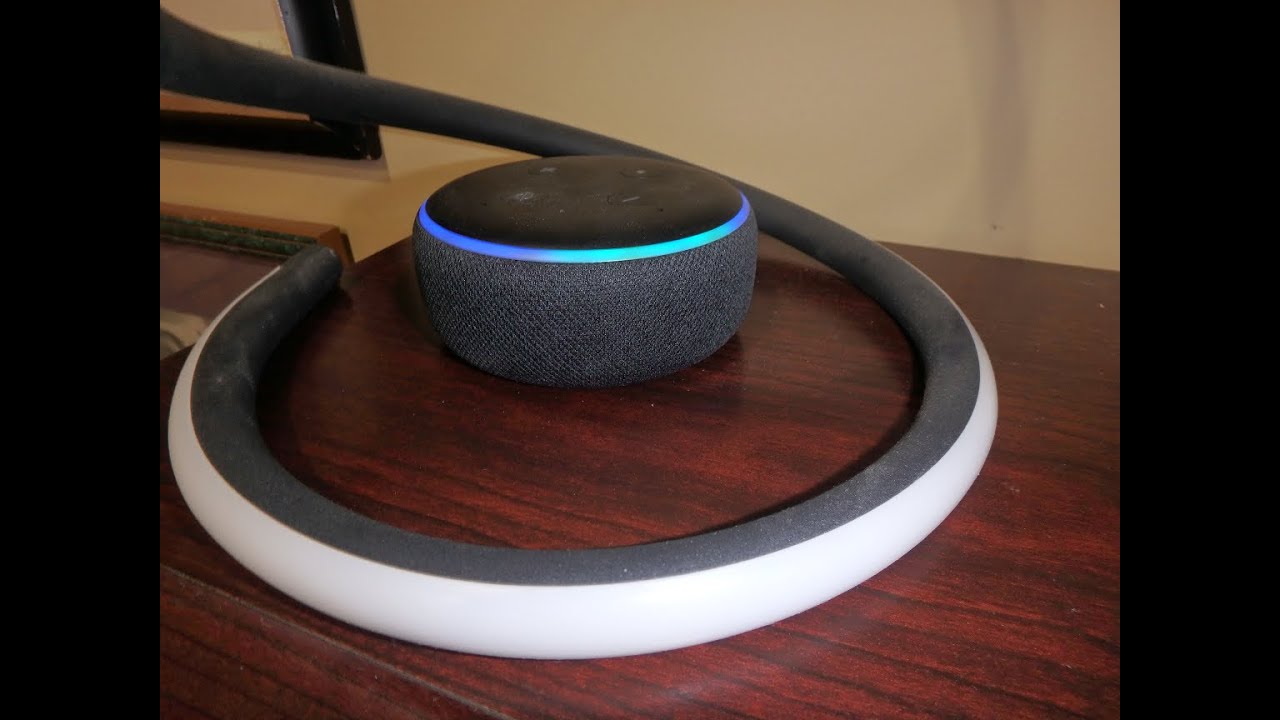Home>Home Appliances>Home Automation Appliances>How To Get Listed On Alexa Voice Search


Home Automation Appliances
How To Get Listed On Alexa Voice Search
Published: January 5, 2024
Learn how to optimize your home automation appliances for Alexa voice search and get listed to improve your visibility and reach. Discover the best strategies for voice search optimization.
(Many of the links in this article redirect to a specific reviewed product. Your purchase of these products through affiliate links helps to generate commission for Storables.com, at no extra cost. Learn more)
Introduction
Welcome to the era of voice search! With the increasing prevalence of virtual assistants and smart speakers, voice search has become an integral part of our daily lives. Among the leading players in this domain, Alexa, the virtual assistant developed by Amazon, has gained widespread popularity. As more and more users rely on Alexa for information and assistance, it has become crucial for businesses and websites to optimize their online presence for Alexa voice search.
In this comprehensive guide, we will delve into the nuances of Alexa voice search and explore the strategies you can employ to ensure that your website is effectively listed on this platform. From understanding the intricacies of Alexa voice search to optimizing your website and content, we will equip you with the knowledge and tools to enhance your visibility and accessibility in the voice search landscape. So, let's embark on this enlightening journey to unravel the secrets of getting listed on Alexa voice search and maximizing your digital presence!
Key Takeaways:
- Embrace the conversational nature of voice search by using natural language, structured data, and mobile-friendly design to optimize your website for Alexa voice search.
- Monitor and analyze your website’s performance on Alexa voice search to refine your content and strategies, enhancing visibility and resonance with voice search users.
Read more: How To Get Shopping List From Alexa
Understanding Alexa Voice Search
To effectively optimize your website for Alexa voice search, it is essential to grasp the fundamental workings of this innovative technology. Alexa voice search operates through natural language processing and machine learning algorithms, enabling users to interact with the virtual assistant using voice commands. When a user initiates a voice search query, Alexa leverages its sophisticated speech recognition capabilities to comprehend the spoken words, decipher the intent behind the query, and retrieve relevant information from its vast repository of data.
Unlike traditional text-based searches, voice queries are often more conversational and contextually rich, reflecting the natural manner in which individuals articulate their information needs. This necessitates a shift in the approach to search engine optimization (SEO), as optimizing for voice search entails understanding and catering to the nuances of spoken language and user intent.
Furthermore, Alexa’s ability to perform a wide array of tasks, such as providing weather updates, setting reminders, playing music, and controlling smart home devices, underscores the multifaceted nature of voice interactions. This multifunctional aspect of Alexa voice search underscores the diverse opportunities it presents for businesses to engage with their target audience in innovative ways.
By comprehending the intricacies of how Alexa voice search operates and the distinct characteristics of voice queries, you can lay a solid foundation for devising effective strategies to enhance your website’s visibility and accessibility in the voice search ecosystem.
Importance of Being Listed on Alexa Voice Search
Being listed on Alexa voice search holds immense significance in the current digital landscape, where voice-enabled devices have permeated households and workplaces, transforming the way individuals seek information and interact with technology. As the adoption of voice search continues to soar, securing a prominent presence on Alexa voice search can yield a plethora of benefits for businesses and website owners.
Enhanced Visibility and Accessibility: With the proliferation of smart speakers and voice-activated devices, users are increasingly turning to voice search to fulfill their information needs. By ensuring that your website is listed on Alexa voice search, you can bolster its visibility and accessibility to a vast audience that relies on voice commands to navigate the digital realm.
Competitive Edge: Embracing Alexa voice search optimization allows you to gain a competitive edge in your industry. By proactively adapting to the evolving search landscape, you position your business to outshine competitors and cater to the preferences of users who gravitate towards voice-based interactions.
Enriched User Experience: Facilitating seamless access to your content through Alexa voice search contributes to an enriched user experience. By catering to the preferences of users who prefer voice-driven interactions, you can foster stronger connections with your audience and streamline the process of accessing relevant information or services.
Brand Visibility and Authority: Securing a prominent presence on Alexa voice search reinforces your brand’s visibility and authority in the digital sphere. When users receive accurate and valuable information from your website in response to voice queries, it cultivates trust and establishes your brand as a reliable source of expertise in your niche.
Anticipating Future Trends: Embracing Alexa voice search optimization positions your business to anticipate and adapt to future search trends. As voice search continues to evolve and shape user behaviors, staying ahead of the curve empowers you to align your digital strategies with the preferences and habits of contemporary consumers.
By recognizing the pivotal role of Alexa voice search in shaping the digital landscape, businesses can harness its potential to elevate their online presence, engage with their audience in innovative ways, and stay attuned to the evolving dynamics of search and user interaction.
Optimizing Your Website for Alexa Voice Search
Optimizing your website for Alexa voice search entails a strategic approach that aligns with the unique dynamics of voice-based interactions. By implementing targeted measures, you can enhance your website’s compatibility with Alexa voice search and elevate its visibility in response to voice queries.
1. Structured Data and Schema Markup: Incorporating structured data and schema markup into your website’s code can significantly enhance its compatibility with voice search. By providing search engines, including Alexa, with structured information about your content, you facilitate the delivery of precise and relevant results in response to voice queries.
2. Mobile-Friendly Design: Given the prevalence of voice search on mobile devices, optimizing your website for mobile compatibility is paramount. A responsive and mobile-friendly design ensures that users accessing your website via voice search encounter a seamless and intuitive browsing experience, thereby bolstering user engagement and satisfaction.
3. Local SEO Optimization: For businesses with physical locations, optimizing for local SEO is instrumental in catering to voice search queries related to nearby services and establishments. Ensuring that your business information, such as address, contact details, and operational hours, is accurately listed on your website and across relevant directories enhances its visibility in local voice search results.
4. Natural Language and Conversational Keywords: Voice queries often mirror conversational language patterns, necessitating the incorporation of natural language and conversational keywords into your website’s content. By aligning your content with the way users articulate voice queries, you can augment its relevance and resonance in response to voice-based searches.
5. Page Speed Optimization: Fast-loading web pages are pivotal in delivering a seamless voice search experience. Optimizing your website’s page speed enhances its responsiveness to voice search queries, ensuring that users receive prompt and relevant information without encountering delays or impediments.
6. FAQ Pages and Structured Content: Crafting FAQ pages and structured content that address common queries related to your industry or offerings can bolster your website’s relevance in voice search results. By structuring your content to provide succinct and informative responses to frequently asked questions, you enhance its suitability for voice-based interactions.
By implementing these targeted strategies, you can fortify your website’s compatibility with Alexa voice search and position it to deliver valuable and relevant information to users engaging with the virtual assistant through voice commands. Embracing the nuances of voice search optimization empowers you to cultivate a robust digital presence that resonates with the preferences and behaviors of contemporary users.
Optimize your website content with natural language keywords and phrases that people are likely to use when speaking to a voice assistant. This will increase the chances of your website being listed on Alexa Voice Search.
Creating Voice Search-Friendly Content
Crafting voice search-friendly content involves tailoring your textual and multimedia assets to align with the natural language and conversational nuances characteristic of voice-based interactions. By infusing your content with elements that resonate with the preferences of voice search users, you can enhance its relevance and accessibility in response to voice queries.
1. Conversational Tone and Clarity: When creating content intended for voice search optimization, adopt a conversational tone that mirrors the manner in which individuals articulate their queries. Strive for clarity and succinctness, ensuring that your content delivers comprehensive information in a concise and easily understandable manner.
2. Long-Tail Keywords and Phrases: Incorporate long-tail keywords and phrases that align with the conversational nature of voice queries. By integrating natural language and contextually relevant keywords into your content, you enhance its resonance with the diverse range of voice search queries users are likely to pose.
3. Addressing User Intent: Anticipate and address the underlying intent behind voice search queries within your content. By providing comprehensive and contextually rich information that aligns with the diverse intentions of users, you can position your content to be prominently featured in response to a broad spectrum of voice-based inquiries.
4. Multimedia Enrichment: Enrich your content with multimedia elements, such as images, videos, and infographics, to complement textual information. Multimedia assets not only enhance the engagement and comprehensibility of your content but also cater to the preferences of voice search users seeking diverse forms of information through voice-based interactions.
5. Structured and Informative Responses: Craft your content to provide structured and informative responses to common queries within your niche or industry. By addressing frequently asked questions and pertinent topics in a clear and organized manner, you augment the suitability of your content for voice search interactions.
6. Contextual Relevance and Localization: Tailor your content to reflect the contextual relevance and localization pertinent to your target audience. By integrating location-specific information and contextually relevant details, you enhance the suitability of your content for local voice search queries and user-specific preferences.
By infusing your content with these voice search-friendly attributes, you can fortify its compatibility with Alexa voice search and position it as a valuable and accessible resource for users engaging with the virtual assistant through voice commands. Embracing the nuances of voice search optimization empowers you to create content that seamlessly aligns with the natural language and conversational dynamics of voice-based interactions, thereby enriching the user experience and bolstering the visibility of your digital assets.
Read more: How To Search For Alexa Skills
Leveraging Schema Markup for Voice Search
Schema markup, a structured data vocabulary that can be added to your website’s HTML to improve the way search engines read and represent your page in search results, plays a pivotal role in optimizing your content for voice search, including Alexa voice search. By incorporating schema markup into your website, you can provide search engines, including Alexa, with detailed and contextually rich information about your content, thereby enhancing its suitability for voice-based interactions.
1. Rich Snippets and Enhanced Visibility: Schema markup enables the creation of rich snippets, which are enhanced search results that display additional information, such as ratings, reviews, and product details. By leveraging schema markup to generate rich snippets, you can augment the visibility and prominence of your content in response to voice search queries, thereby increasing the likelihood of it being featured as a valuable resource by Alexa.
2. Contextual Categorization and Entity Recognition: Schema markup facilitates the contextual categorization of your content and the recognition of entities mentioned within it. By structuring your content with schema markup, you provide search engines, including Alexa, with clear signals about the nature and relevance of your content, enabling them to deliver precise and contextually relevant results in response to voice queries.
3. Local Business Information and Accessibility: For businesses with physical locations, leveraging schema markup to provide detailed local business information enhances their visibility and accessibility in local voice search results. By incorporating location-specific schema markup, such as business hours, contact details, and geographic coordinates, you can fortify your website’s compatibility with Alexa voice search for location-based queries.
4. FAQPage and Q&A Schema: Implementing FAQPage and Q&A schema markup can enrich your content with structured and informative responses to frequently asked questions. By utilizing these schema types, you enhance the suitability of your content for voice search interactions, as it provides clear and concise answers to common queries, aligning with the conversational and contextually rich nature of voice-based interactions.
5. Product and Offer Details: E-commerce websites can leverage schema markup to provide detailed product and offer information, including pricing, availability, and reviews. By enriching product pages with schema markup, businesses can optimize their content for voice search, facilitating the delivery of accurate and comprehensive product details in response to voice queries.
By harnessing the capabilities of schema markup, you can fortify your content’s compatibility with Alexa voice search and enhance its visibility and relevance in response to voice queries. Embracing schema markup empowers you to provide search engines, including Alexa, with structured and detailed information about your content, thereby positioning it to be prominently featured in voice search interactions and cater to the diverse information needs of voice search users.
Monitoring and Analyzing Your Performance on Alexa Voice Search
After implementing strategies to optimize your website and content for Alexa voice search, it is imperative to monitor and analyze your performance to gauge the efficacy of your efforts and make informed refinements. By leveraging insightful analytics and monitoring tools, you can gain valuable insights into how your website is being accessed and engaged with through Alexa voice search, empowering you to refine your strategies and enhance your visibility in the voice search landscape.
1. Voice Search Analytics: Utilize voice search analytics tools to track and analyze the voice search queries that lead users to your website. By gaining visibility into the specific voice queries that resonate with your content, you can tailor your optimization strategies to align with the prevalent trends and preferences of Alexa voice search users.
2. User Engagement Metrics: Assess user engagement metrics, such as bounce rate, session duration, and conversion rates, for visitors accessing your website through Alexa voice search. By evaluating how voice search users interact with your content, you can discern patterns and preferences that inform the refinement of your content and user experience to better cater to voice search traffic.
3. Keyword Performance and Relevance: Evaluate the performance and relevance of keywords and phrases that drive traffic from Alexa voice search. By identifying high-performing voice search keywords and assessing their contextual relevance, you can optimize your content to resonate with the prevalent voice search queries and user intents.
4. Schema Markup Effectiveness: Assess the effectiveness of schema markup in enhancing the visibility and relevance of your content in response to voice search queries. By monitoring the performance of structured data and schema markup, you can refine and expand its utilization to fortify your content’s compatibility with Alexa voice search.
5. Competitive Benchmarking: Conduct competitive benchmarking to compare your performance in Alexa voice search with that of industry peers and competitors. By gaining insights into the strategies and content attributes that contribute to their visibility in voice search results, you can refine your own approach and identify areas for improvement.
6. Content Refinement and Optimization: Based on the insights gleaned from monitoring and analysis, refine and optimize your content to better align with the prevalent voice search queries and user preferences. Continuously iterate on your content strategy to enhance its resonance with Alexa voice search users and cater to their information needs effectively.
By diligently monitoring and analyzing your performance on Alexa voice search, you can refine your optimization strategies, enhance the relevance of your content, and fortify your visibility in response to voice queries. Embracing a data-driven approach empowers you to adapt to the evolving dynamics of voice search and position your website as a valuable and accessible resource for users engaging with Alexa through voice commands.
Conclusion
As voice search continues to shape the digital landscape, embracing the nuances of Alexa voice search optimization is paramount for businesses and website owners seeking to enhance their digital presence and engage with contemporary consumers. By understanding the intricacies of voice-based interactions and tailoring your strategies to align with the preferences and habits of voice search users, you can fortify your website’s compatibility with Alexa voice search and position it as a valuable and accessible resource in the voice search ecosystem.
From comprehending the fundamental workings of Alexa voice search to optimizing your website, content, and schema markup, this comprehensive guide has equipped you with the knowledge and tools to navigate the complexities of voice search optimization. By infusing your content with voice search-friendly attributes, leveraging schema markup to provide detailed and structured information, and monitoring your performance to refine your strategies, you can elevate your visibility and resonance in response to voice queries.
As you embark on your journey to optimize your website for Alexa voice search, remember that the key lies in embracing the conversational and contextually rich nature of voice-based interactions. By crafting content that aligns with the natural language and user intent prevalent in voice search queries, you can foster stronger connections with your audience and cater to their information needs in innovative ways.
Embracing a data-driven approach to monitoring and refining your performance in Alexa voice search empowers you to adapt to the evolving dynamics of voice-based interactions and position your website as a prominent and reliable source of expertise in your niche. By staying attuned to the preferences and habits of contemporary consumers, you can anticipate and capitalize on the opportunities presented by Alexa voice search, thereby fortifying your digital presence and enriching the user experience.
As the voice search landscape continues to evolve, the strategies and insights outlined in this guide will serve as your compass, guiding you towards a robust and optimized presence on Alexa voice search. By integrating these principles into your digital strategies, you can navigate the complexities of voice search optimization with confidence and carve a distinctive niche in the dynamic realm of voice-based interactions.
Frequently Asked Questions about How To Get Listed On Alexa Voice Search
Was this page helpful?
At Storables.com, we guarantee accurate and reliable information. Our content, validated by Expert Board Contributors, is crafted following stringent Editorial Policies. We're committed to providing you with well-researched, expert-backed insights for all your informational needs.















0 thoughts on “How To Get Listed On Alexa Voice Search”